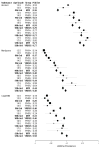Prevalence of and risk factors for substance use among perinatally human immunodeficiency virus-infected and perinatally exposed but uninfected youth
- PMID: 24239286
- PMCID: PMC3944021
- DOI: 10.1016/j.jadohealth.2013.09.003
Prevalence of and risk factors for substance use among perinatally human immunodeficiency virus-infected and perinatally exposed but uninfected youth
Abstract
Purpose: This study examined risk factors associated with recent substance use (SU) among perinatally human immunodeficiency virus (HIV)-infected (PHIV+) and perinatally exposed, uninfected (PHEU) youth and compared SU lifetime prevalence with the general population of United States (U.S.) adolescents.
Methods: We conducted cross-sectional and longitudinal analyses of 511 PHIV+ and PHEU youth (mean age at study entry, 13.2 years; 51% female; 69% PHIV+; and 72% African-American) enrolled in a U.S. multisite prospective cohort study between 2007 and 2009. Substance use data were collected by audio computer-assisted self-interview. Youth Risk Behavior Surveillance System and Monitoring the Future data were used to compare SU lifetime prevalence with U.S. samples.
Results: Perinatal HIV infection was not a statistically significant risk factor for alcohol or marijuana use. Risk factors for alcohol use among PHIV+ youth included higher severity of emotional and conduct problems and alcohol and marijuana use in the home by the caregiver or others. Risk factors for marijuana use among PHIV+ youth included marijuana use in the home, higher severity of conduct problems, and stressful life events. Similar SU risk factors among PHEU youth included SU in the home and higher severity of conduct and emotional problems. Overall lifetime prevalence of SU by age was similar to that in national surveys.
Conclusions: Although SU lifetime prevalence and risk factors for PHIV+ and PHEU adolescents were similar to national norms, the negative consequences are potentially greater for PHIV+ youth. Prevention efforts should begin before SU initiation and address the family and social environment and youth mental health status.
Keywords: Adolescent risk behavior; Adolescents; Human immunodeficiency virus; Perinatal human immunodeficiency virus exposure; Substance use.
Copyright © 2014 Society for Adolescent Health and Medicine. Published by Elsevier Inc. All rights reserved.
Conflict of interest statement
Figures

Similar articles
-
Substance use and the development of sexual risk behaviors in youth perinatally exposed to HIV.J Pediatr Psychol. 2015 May;40(4):442-54. doi: 10.1093/jpepsy/jsu103. Epub 2014 Dec 3. J Pediatr Psychol. 2015. PMID: 25476800 Free PMC article.
-
Mental health functioning among children and adolescents with perinatal HIV infection and perinatal HIV exposure.AIDS Care. 2011 Dec;23(12):1533-44. doi: 10.1080/09540121.2011.575120. AIDS Care. 2011. PMID: 21702707 Free PMC article.
-
Human Papillomavirus Antibody Levels and Quadrivalent Vaccine Clinical Effectiveness in Perinatally Human Immunodeficiency Virus-infected and Exposed, Uninfected Youth.Clin Infect Dis. 2019 Sep 13;69(7):1183-1191. doi: 10.1093/cid/ciy1040. Clin Infect Dis. 2019. PMID: 30927547 Free PMC article.
-
Understanding the mental health of youth living with perinatal HIV infection: lessons learned and current challenges.J Int AIDS Soc. 2013 Jun 18;16(1):18593. doi: 10.7448/IAS.16.1.18593. J Int AIDS Soc. 2013. PMID: 23782478 Free PMC article. Review.
-
Sexual Development in Perinatally HIV-Infected Young People: A Systematic Review and Explorative Study.Sex Med. 2022 Dec;10(6):100578. doi: 10.1016/j.esxm.2022.100578. Epub 2022 Oct 20. Sex Med. 2022. PMID: 36274460 Free PMC article. Review.
Cited by
-
Projected Life Expectancy for Adolescents With HIV in the US.JAMA Health Forum. 2024 May 3;5(5):e240816. doi: 10.1001/jamahealthforum.2024.0816. JAMA Health Forum. 2024. PMID: 38728022 Free PMC article.
-
Oral Human Papillomavirus in Youth From the Pediatric HIV/AIDS Cohort Study.Sex Transm Dis. 2016 Aug;43(8):498-500. doi: 10.1097/OLQ.0000000000000495. Sex Transm Dis. 2016. PMID: 27414680 Free PMC article.
-
Oral microbiota in youth with perinatally acquired HIV infection.Microbiome. 2018 May 31;6(1):100. doi: 10.1186/s40168-018-0484-6. Microbiome. 2018. PMID: 29855347 Free PMC article.
-
Alcohol and illicit drug use among young people living with HIV compared to their uninfected peers from the Kenyan coast: prevalence and risk indicators.Subst Abuse Treat Prev Policy. 2021 Nov 24;16(1):86. doi: 10.1186/s13011-021-00422-6. Subst Abuse Treat Prev Policy. 2021. PMID: 34819121 Free PMC article.
-
Relationship between brain structural network integrity and emotional symptoms in youth with perinatally-acquired HIV.Brain Behav Immun. 2024 Feb;116:101-113. doi: 10.1016/j.bbi.2023.11.026. Epub 2023 Dec 2. Brain Behav Immun. 2024. PMID: 38043871 Free PMC article.
References
-
- Johnston LD, O’Malley PM, Bachman JG, et al. Monitoring the Future National Results on Adolescent Drug Use: Overview of Key Findings, 2010. Ann Arbor, Michigan: Institute for Social Research, University of Michigan; 2011.
-
- Murphy DA, Belzer M, Durako SJ, et al. Longitudinal Antiretroviral Adherence Among Adolescents Infected with Human Immunodeficiency Virus. Arch Pediatr Adolesc Med. 2005;159:764–770. - PubMed
-
- Koenig LJ, Pals SL, Chandwani S, et al. Sexual Transmission Risk Behavior of Adolescents With HIV Acquired Perinatally or Through Risky Behaviors. J Acquir Immune Defic Syndr. 2010;55:380–90. - PubMed
Publication types
MeSH terms
Grants and funding
LinkOut - more resources
Full Text Sources
Other Literature Sources
Medical

